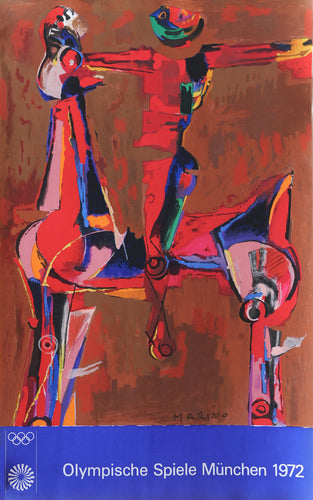
'Chevaux et Cavaliers V'
Though a multidisciplinary artist who worked successfully in the spheres of sculpture, painting, and printmaking, in subject matter Marini tended to a narrow range of universal themes: the Pomonas, earthly female nudes that invoke the Roman goddess of fruit and fertility; jugglers, dancers, and acrobatic performers; and, most especially, the horse and rider.
'Due Pomone' - 'Two Pomonas', Marini's archetypical nude female goddesses
The latter dominates L’Album No. 1, as it had done most of Marini’s career. Historically it was a potent, even primal symbol of human civilisation, in which the taming of the first wild horse represented the subordination of man’s animal instincts. It held significance for almost every ancient empire, from Assyria to Marini’s own Etruscan ancestors, for whom the horseman symbolised virility and vitality. But it was the horse’s power as a visual element – its long, straining muzzle, its elegant musculature – that first drew Marini to interpret its form in paint and clay: ‘At the beginning of my career I rented, by chance, a studio belonging to the owner of a riding school. Consequently, I had an opportunity to draw and model horses every day; but at the time they were still far from giving me inspiration for a subjective or apocalyptic vision.’

'Chevaux et Cavaliers III'
With time, this fascination with form developed into one of allegory. In the horseman, an icon of epic and imperial strength, Marini foresaw an analogy with the militaristic hubris of the Second World War and the atomic age that proceeded it. The development of his own riders mapped this fall from the heroic to the tragic: at first stately and static, in the mould of a noble Marcus Aurelius or Napoleon on horseback, by the time Marini came to collate the L’Album No. 1 portfolio in the late 1960s, his riders had lost control. Their steeds bray and champ with mad rolling eyes, lips curled and hooves nervously pawing the ground: ‘The restlessness of my horses increases with each new work; the riders become ever more impotent, losing command over the animals.’

'Il Sogno del Cavaliere' - 'The Knight's Dream'
These are the horses that stand, transfixed, throughout L’Album, as if caught in a bright light. Despite its title, L’Album No. 1 was the second collection of prints Marini had published. It contained a series of etchings, related only in subject, tone, and tenor, produced between 1950 and 1962. Marini first learnt to etch before taking up sculpture, embarking on a course in engraving while a student in Florence in the early 1920s. Though he is today known primarily for his three-dimensional work, graphics frequently anticipated his monumental sculptures. He noted during his lifetime how every model he had produced had some preparatory drawing, painting or print from which it was developed. After the war, etching became particularly important to Marini, a medium in which he could experiment and explore thematically before committing an idea to clay.

'Teatro Delle Maschere' - 'Theatre of Masks'
Etching offered a further advantage in that its plates could be worked on intermittently, picked up one month and put down the next. For this very reason the selection of prints contained in L’Album offers a fascinating insight into Marini’s development of the horse and rider theme: as well as charting his horseman’s downward spiral from early stoic warriors to madcap performers, we see Marini picking up plates begun some fifteen years earlier and revitalising old compositions with a new strength of vision.

'L'Idea del Cavaliere' - 'The Knight's Idea'
Far from the pessimistic prophecy Marini offered as the conclusion of his horse and rider theme, in L’Album there pervades an atmosphere of restless twilight, what one critic has called the ‘tormented serenity’ of Marini’s art. In its collected scenes, Marini runs the theatrical gamut from heroic to tragi-comic. His host of characters are spectral; they hover, disintegrate, merge with the shadows, and explode into geometric form.

'Giocolieri' - 'Jugglers'
Prints like Giocolieri – ‘Jugglers’ – show Marini at his most inventive. Patches of cross-hatching, usually used in etching to define the contours of a three-dimensional form, serve here as a mysterious backdrop; the figures remain flat and ghostly white, projecting out beyond the shadows. In the absence of juggling balls, the heads of each figure transform into floating orbs that take their place, listing and rolling along their shoulders. Spaced across the plate from bottom left to right, their faces replicate a juggler’s throwing arc, four peaceful little heads tilting like moons in transitory orbit.

'L'Invocazione' - 'The Invocation'
Marini exhibited a great many artistic strengths in his graphic work. In etchings like L’Invocazione, with a supplicant, Christ-like figure atop a leering mount, he showed he could unite profound universal themes and present them with sadness, strangeness, and a kind of lunatic humour all at once. A local Tuscan boy born in the town of Pistoia, he attributed his archaic symbolism to his Etruscan descent: ‘My very self is born there, in that region. Those are my ancestors. It is a civilisation which even today comes up out of the ground, it is a root which still nourishes, which still lives. I feel extremely bound to this ground, to this sense of people, ancient, but so alive, so intelligent. I have it in my blood, I cannot rid myself of it.’

'Trio' - three of Marini's dreamworld performers
In L’Album No. 1 it is to this ancient root that he returns, to a time of myth and magic. He reimagines riders and circus performers, archetypes as old as civilisation itself, and somehow makes them both old and new; cosmic and arcane.










